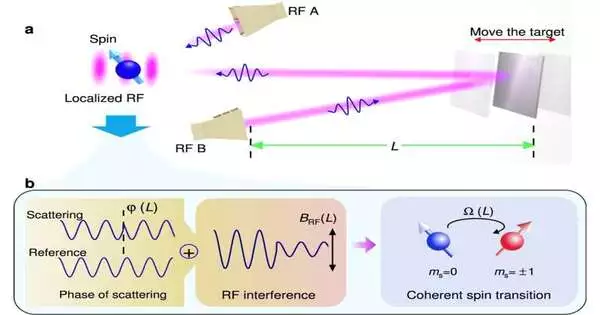In a study that was published in Nature Communications, a group led by Professor Guo Guangcan and Academician Guo Guangcan describes the advancements made in real-world quantum sensing. Sun Fangwen is a researcher at the Chinese Academy of Sciences’ University of Science and Technology of China (USTC). In order to study the detection of microwave signals and wireless ranging, the team combined micro- and nano-quantum sensing with local electromagnetic field enhancement at deep sub-wavelength scales, resulting in positioning accuracy of 10-4 wavelengths.
Numerous applications of radar positioning technology based on microwave signal measurement include automatic driving, intelligent manufacturing, health monitoring, and geological exploration. In order to create high-sensitivity microwave detection and high-precision microwave positioning technology, the research team combined quantum sensing of solid-state systems with micro- and nanoscale resolution and deep subwavelength localization of electromagnetic fields.
In order to gather and focus microwave signals that are traveling through free space into nanospace, the researchers created a composite microwave antenna made of metal nanostructures and diamond spin quantum sensors. They measured the microwave signals by measuring the solid-state quantum probe state in the neighborhood. The process changed the detection of weak signals in free space into the detection of electromagnetic fields and solid-state spin interactions at the nanoscale, increasing the microwave signal measurement sensitivity of solid-state quantum sensors by 3–4 orders of magnitude.
The researchers constructed a microwave interferometry device based on the diamond quantum sensor in order to further exploit high-sensitivity microwave detection to achieve high-precision microwave localization. Using solid-state spin detection, they were able to determine the phase of the reflected microwave signal and the position information of the object. They were able to achieve quantum-enhanced position measurement with an accuracy of 10 micrometers (roughly one ten-thousandth of the wavelength) by repeatedly coherently interacting microwave photons with solid-state spin quantum probes.
This quantum measurement method differs from conventional radar systems in that it does not call for active detectors like amplifiers, which lessens the influence of electronic noise and other factors on the measurement limit. The development of usable solid-state quantum radar localization technology that outperforms the capabilities of current radars will be made possible by further research, which will enhance radio localization accuracy, sampling rate, and other indicators based on solid-state spin quantum sensing.
More information: Xiang-Dong Chen et al, Quantum enhanced radio detection and ranging with solid spins, Nature Communications (2023). DOI: 10.1038/s41467-023-36929-8





